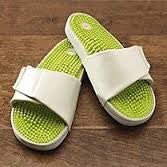Reflexology Treatment

A reflexology session begins with the practitioner conducting a brief health history, checking in case reflexology might not be the best choice of therapy for you.
The practitioner explains how reflexology works and what happens during a session. The reflexologist also informs you that reflexology does not treat specific illness and is not a substitute for medical treatment. You may be asked to sign a consent form.
How does a Typical session start
The practitioner may choose to work only on the feet, or the hands, or the ears, depending on your specific health issues. Some problems respond better to work on the feet, others to work on the hands; yet others respond better to the reinforcement of work on all three - hands, ear and feet. In some situations, for example a patient in the hospital may have IV's and multiple tubes and wires, so a reflexology sesssion may be limited to the feet by necessity
If the reflexologist chooses to work on your feet, you will lie or sit down, remaining fully clothed except for your shoes and socks. The practitioner may wash your feet and soak them in warm water, then position them at his or her chest level
What is the Focus of the session
Having a specific condition in mind allows the reflexologist to carefully feel and work the area corresponding to the presenting problem. However reflexologist will work all areas of the foot with gentle pressure, because, according to reflexology theories, this allows the nerve pathways and congestion to release and promotes the relaxation response for the entire body.
What is a refelxology Treatment
A complete reflexology therapy session uses many different techniques and includes all of the points on both feet (and perhaps the hands and ears). The session generally starts at the fingers or toes, and works down to the heel of the hand or foot, then works the areas on the sides and top.
By working all of the points, the reflexologist addresses internal organs and glands as well as muscle groups, bones, nerve ganglions (solar plexus, brachial plexus) and nerves (sciatic) during a session.
What will I experience During the Session
Many people experience a "lightness" or tingling in the body, as well as feelings of warmth, a sense of "opening," or "energy moving" from the practitioner's pressure to the specific body area or organ. There is often a physical perception of energy flowing through every organ, valve, gland, or muscle, as well as a sense of communication between each body system.
What happens at theend of the session
Most reflexologists have some type of calm, peaceful way of closing the session that involves stroking the hand or foot and holding the limb in some manner. The important aspect is for you to feel comforted and nurtured, and to feel that you have had time for yourself during the session.
Now that the session is complete, you should not feel rushed. Gently bring yourself back into the present moment, and orient yourself. As you feel comfortable, gather yourself and your belongings to leave.
How many Sessions are needed
The number of sessions varies and is determined by the client's health and reasons for seeking reflexology. But in general, results from reflexology are often subtle and are cumulative. Thus, you are more likely to see greater benefits from regular sessions (for example, once a week for six weeks) than if you had a session once every six months.



